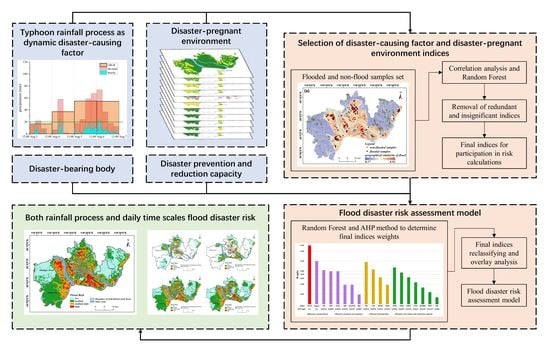Urban Flood Dynamic Risk Assessment Based on Typhoon Rainfall Process: A Case Study of Typhoon “Lupit” (2109) in Fuzhou, China
Abstract
1. Introduction
2. Study Area and Typhoon Overview
2.1. Study Area
2.2. Typhoon Overview
3. Data Preprocessing
4. Methods
4.1. Calculation of Risk Assessment Index
4.1.1. Influencing Elements of Typhoon Rainfall Process
4.1.2. Typhoon-Rainfall Process Comprehensive Intensity Index (TPCI)
4.2. Screening of Disaster-Causing Factors and Disaster-Pregnant Environmental Indices
4.2.1. Geographical Similarity
4.2.2. Random Forest
4.3. Flood Disaster Risk Assessment Model
5. Results
5.1. Analysis of TPCI
5.1.1. Calculation Results of TPCI
5.1.2. Validation of TPCI Results
5.2. Analysis of Flood Disaster Dynamic Risk
5.2.1. Risk Assessment
5.2.2. Validation of Risk Assessment Results
6. Discussion
7. Conclusions
- The TPCI was developed by using regional precipitation thresholds and considered the effects of precipitation intensity, duration, and concentration on rainfall processes at different time scales. This index is a scientifically valid measure that is user-friendly and easy to calculate. Its feasibility was tested and verified using both short-term (6 h) and daily (24 h) precipitation time scales. The results showed that 66.5% of the flood locations were classified as having a medium-grade or higher TPCI value, 32.5% had a low-grade TPCI value, and only 1% were not identified by the TPCI. The study also found that uniform rainfall patterns were associated with a higher likelihood of flooding, particularly at greater precipitation amounts.
- A total of 23 initial assessment indices were selected from four aspects: the disaster-causing factor, disaster-pregnant environment, disaster-bearing body, and disaster prevention and reduction capacity. Non-flooded samples were obtained based on the similarity of the flooded area’s geographical environmental features, and the random forest algorithm was used to analyse the importance of the initial indices. Based on the results of the importance analysis, four indices, namely, TS, RC, FVC, and TA, were discarded. Consequently, the urban flood risk assessment index system was constructed using the remaining 19 indices, which not only reduced data noise, but also provided a relatively objective way of screening assessment indices.
- By employing the hierarchical analysis process and the RF importance results of the initial indices, the flood disaster risk was quantitatively calculated at both a process time scale and a 24 h time scale based on the TPCI results. At the process time scale, the flood disaster high-risk areas, medium–high-risk areas, medium-risk areas, and low-risk areas accounted for 7.08%, 26.47%, 38.19%, and 28.26% of the total study area, respectively. The areas of medium–high-risk and above were mainly distributed in the southeastern and northwestern parts of Changshan District, northern Minhou County, north–central Jin’an District, and northeastern Gulou District. The flood risk results at the 24 h time scale better reflected the spatial and temporal variability of the disaster risk during typhoon rainfall than the results at the process scale. The extreme rainfall period lagged the landfall of Typhoon “Lupit,” resulting in a sharp increase in the proportion of the area at medium–high-risk and above at a 24 h time scale from 8.29% to 23.57% before the typhoon’s landfall. The high-risk areas after the typhoon’s landfall were mainly located in the towns of Shangjie, Nanyu, and Gaishan, which had a high degree of coincidence with the actual disaster situation and were more relevant to the geographical characteristics of the study area.
8. Recommendations
Author Contributions
Funding
Data Availability Statement
Conflicts of Interest
Appendix A
| Maximum Wind Speed near Typhoon Centre * (m/s) | D0 (km) | D1 (km) |
|---|---|---|
| <17.2 | 300 | 800 |
| ≥17.2 | 500 | 1100 |


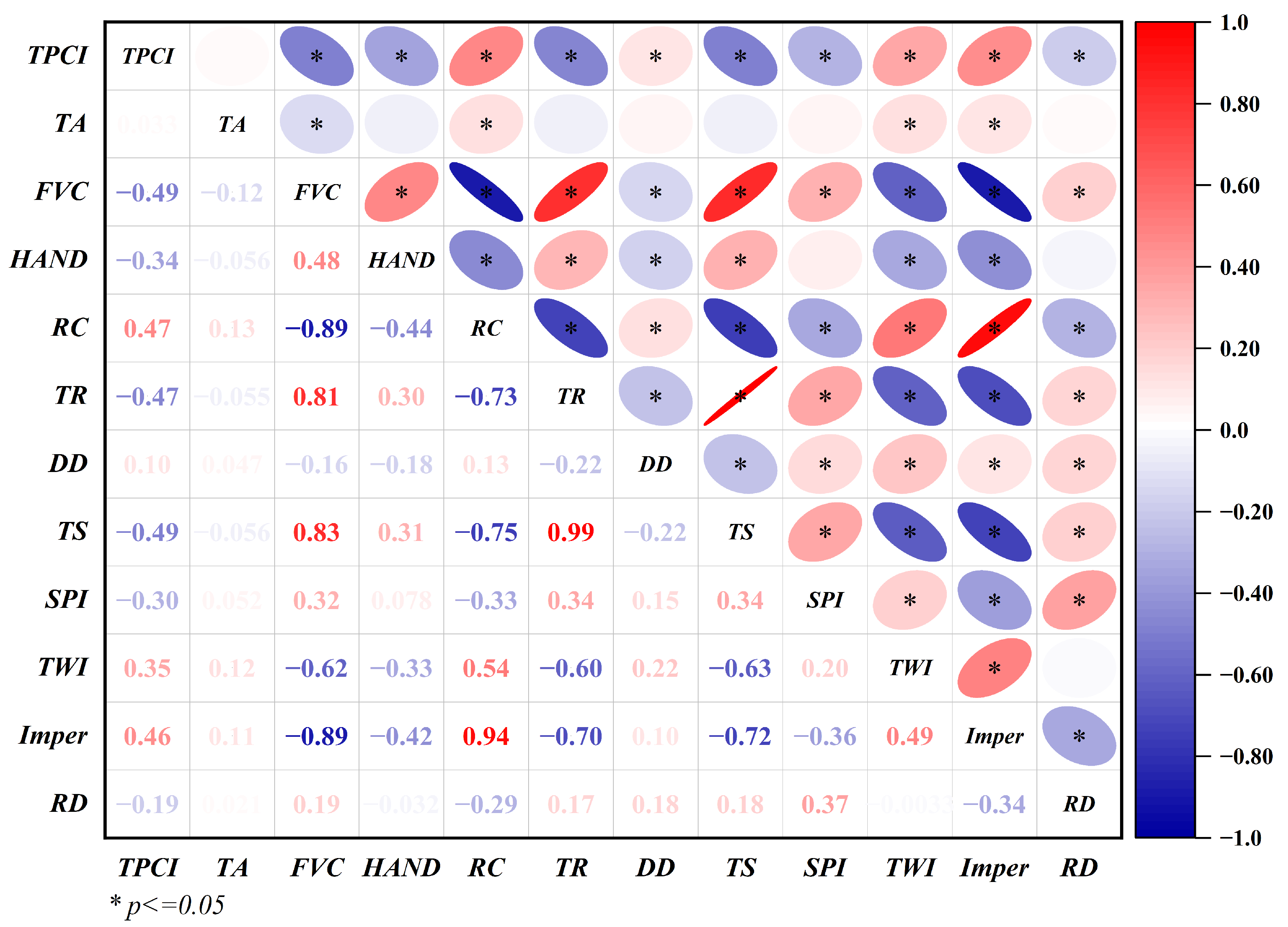
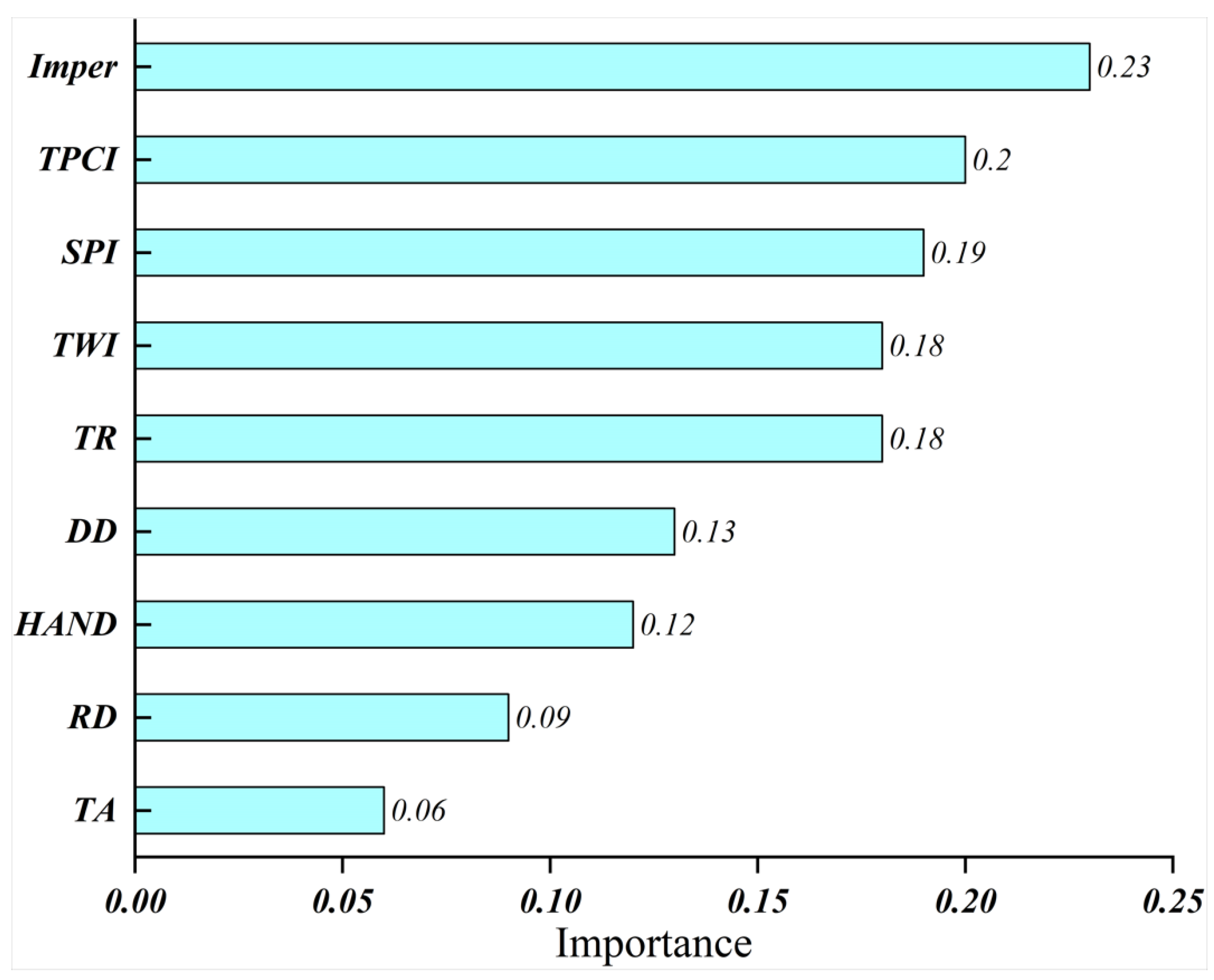
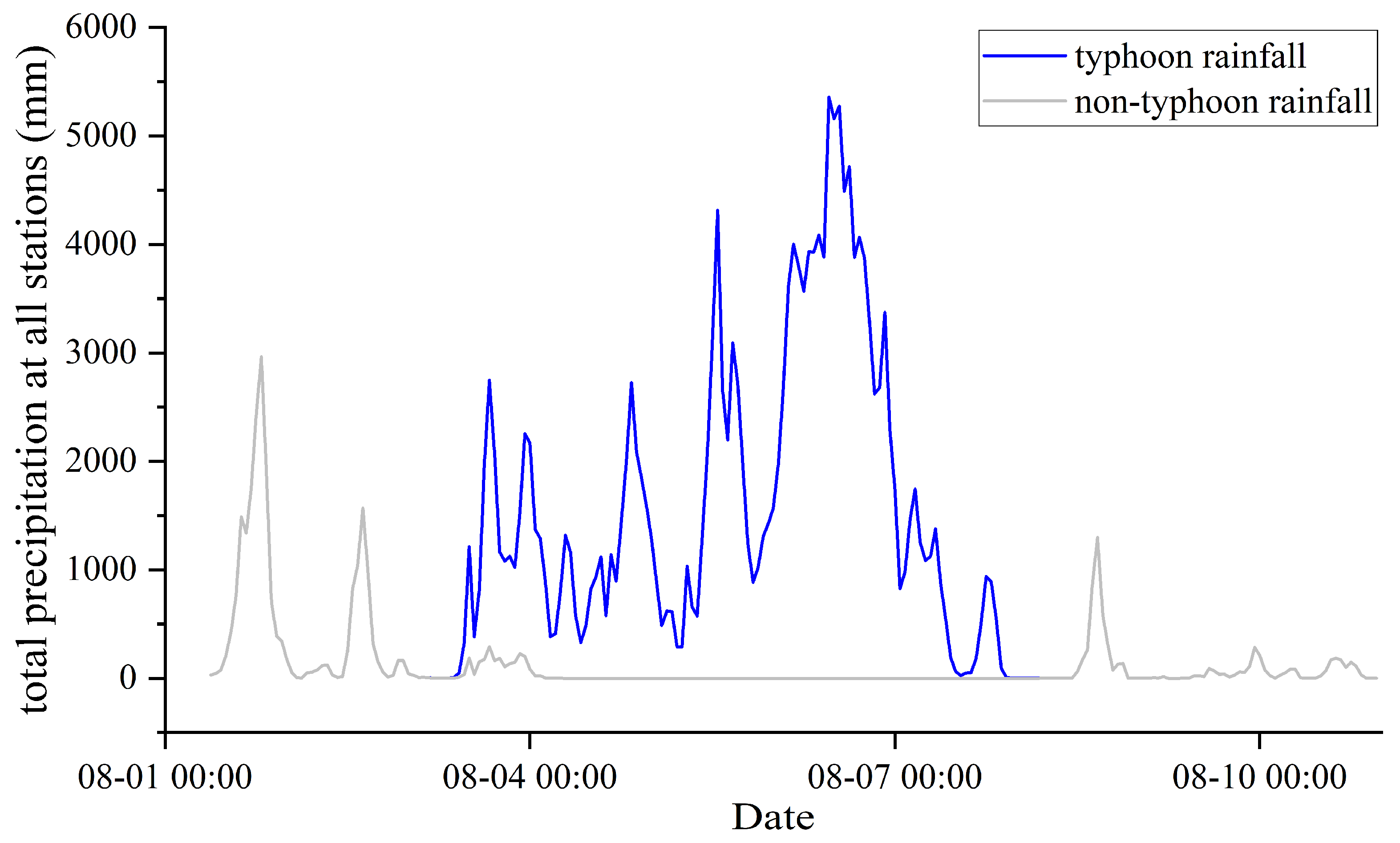

References
- Yin, J.; Yin, Z.; Xu, S. Composite Risk Assessment of Typhoon-Induced Disaster for China’s Coastal Area. Nat. Hazards 2013, 69, 1423–1434. [Google Scholar] [CrossRef]
- Xu, W.; Zhang, M.; Hu, Z.; Guan, X.; Jiang, L.; Bao, R.; Wei, Y.; Ma, M.; Wei, J.; Gao, L. Spatial and Temporal Heterogeneity of Tropical Cyclone Precipitation over China from 1959 to 2018. Front. Environ. Sci. 2022, 10, 1689. [Google Scholar] [CrossRef]
- Chien, F.-C.; Kuo, H.-C. On the Extreme Rainfall of Typhoon Morakot (2009). J. Geophys. Res. Atmos. 2011, 116. [Google Scholar] [CrossRef]
- Zhou, J.; Sun, M.; Xiang, J.; Guan, J.; Du, H.; Zhou, L. Forecasting the Western Pacific Subtropical High Index during Typhoon Activity Using a Hybrid Deep Learning Model. Acta Oceanol. Sin. 2022, 41, 101–108. [Google Scholar] [CrossRef]
- Yumul, G.P.; Servando, N.T.; Suerte, L.O.; Magarzo, M.Y.; Juguan, L.V.V.; Dimalanta, C.B. Tropical Cyclone–Southwest Monsoon Interaction and the 2008 Floods and Landslides in Panay Island, Central Philippines: Meteorological and Geological Factors. Nat. Hazards 2012, 62, 827–840. [Google Scholar] [CrossRef]
- Pan, T.-Y.; Yang, Y.-T.; Kuo, H.-C.; Tan, Y.-C.; Lai, J.-S.; Chang, T.-J.; Lee, C.-S.; Hsu, K.H. Improvement of Watershed Flood Forecasting by Typhoon Rainfall Climate Model with an ANN-Based Southwest Monsoon Rainfall Enhancement. J. Hydrol. 2013, 506, 90–100. [Google Scholar] [CrossRef]
- Guhathakurta, P.; Rajeevan, M.; Sikka, D.R.; Tyagi, A. Observed Changes in Southwest Monsoon Rainfall over India during 1901–2011: Trend in Southwest Monsoon Rainfall over India. Int. J. Climatol 2015, 35, 1881–1898. [Google Scholar] [CrossRef]
- Brand, S.; Blelloch, J.W. Changes in the Characteristics of Typhoons Crossing the Island of Taiwan. Mon. Weather. Rev. 1974, 102, 708–713. [Google Scholar] [CrossRef]
- Yeh, T.-C.; Elsberry, R.L. Interaction of Typhoons with the Taiwan Orography. Part I: Upstream Track Deflections. Mon. Weather. Rev. 1993, 121, 3193–3212. [Google Scholar] [CrossRef]
- Yeh, T.-C.; Elsberry, R.L. Interaction of Typhoons with the Taiwan Orography. Part II: Continuous and Discontinuous Tracks across the Island. Mon. Weather. Rev. 1993, 121, 3213–3233. [Google Scholar] [CrossRef]
- Wang, C.; Wu, J.; Buren, J.; Guo, E.; Liang, H. Modeling the Inter-Regional Economic Consequences of Sequential Typhoon Disasters in China. J. Clean. Prod. 2021, 298, 126740. [Google Scholar] [CrossRef]
- Yin, J.; Gu, H.; Liang, X.; Yu, M.; Sun, J.; Xie, Y.; Li, F.; Wu, C. A Possible Dynamic Mechanism for Rapid Production of the Extreme Hourly Rainfall in Zhengzhou City on 20 July 2021. J. Meteorol. Res. 2022, 36, 6–25. [Google Scholar] [CrossRef]
- Zhao, X.; Li, H.; Qi, Y. Are Chinese Cities Prepared to Manage the Risks of Extreme Weather Events? Evidence from the 2021.07.20 Zhengzhou Flood in Henan Province. SSRN J. 2022, 20. [Google Scholar] [CrossRef]
- Guo, X.; Cheng, J.; Yin, C.; Li, Q.; Chen, R.; Fang, J. The Extraordinary Zhengzhou Flood of 7/20, 2021: How Extreme Weather and Human Response Compounding to the Disaster. Cities 2023, 134, 104168. [Google Scholar] [CrossRef]
- Sivapalan, M.; Savenije, H.H.G.; Blöschl, G. Socio-Hydrology: A New Science of People and Water. Hydrol. Process. 2012, 26, 1270–1276. [Google Scholar] [CrossRef]
- Madani, K.; Shafiee-Jood, M. Socio-Hydrology: A New Understanding to Unite or a New Science to Divide? Water 2020, 12, 1941. [Google Scholar] [CrossRef]
- Witkowski, K. The Development of the Use of Water Energy in the Mountain Catchment from a Sociohydrological Perspective. Energies 2022, 15, 7770. [Google Scholar] [CrossRef]
- Zhu, W.; Cao, Z.; Luo, P.; Tang, Z.; Zhang, Y.; Hu, M.; He, B. Urban Flood-Related Remote Sensing: Research Trends, Gaps and Opportunities. Remote Sens. 2022, 14, 5505. [Google Scholar] [CrossRef]
- Luo, P.; Luo, M.; Li, F.; Qi, X.; Huo, A.; Wang, Z.; He, B.; Takara, K.; Nover, D.; Wang, Y. Urban Flood Numerical Simulation: Research, Methods and Future Perspectives. Environ. Model. Softw. 2022, 156, 105478. [Google Scholar] [CrossRef]
- Titley, H.A.; Cloke, H.L.; Harrigan, S.; Pappenberger, F.; Prudhomme, C.; Robbins, J.C.; Stephens, E.M.; Zsoter, E. Key Factors Influencing the Severity of Fluvial Flood Hazard from Tropical Cyclones. J. Hydrometeorol. 2021, 22, 1801–1817. [Google Scholar] [CrossRef]
- Wang, Y.; Zhang, X.; Tang, Q.; Mu, M.; Zhang, C.; Lv, A.; Jia, S. Assessing Flood Risk in Baiyangdian Lake Area in a Changing Climate Using an Integrated Hydrological-Hydrodynamic Modelling. Hydrol. Sci. J. 2019, 64, 2006–2014. [Google Scholar] [CrossRef]
- Tew, Y.L.; Tan, M.L.; Juneng, L.; Chun, K.P.; bin Hassan, M.H.; bin Osman, S.; Samat, N.; Chang, C.K.; Kabir, M.H. Rapid Extreme Tropical Precipitation and Flood Inundation Mapping Framework (RETRACE): Initial Testing for the 2021–2022 Malaysia Flood. IJGI 2022, 11, 378. [Google Scholar] [CrossRef]
- Wang, Z.; Lai, C.; Chen, X.; Yang, B.; Zhao, S.; Bai, X. Flood Hazard Risk Assessment Model Based on Random Forest. J. Hydrol. 2015, 527, 1130–1141. [Google Scholar] [CrossRef]
- Richardson, D.; Neal, R.; Dankers, R.; Mylne, K.; Cowling, R.; Clements, H.; Millard, J. Linking Weather Patterns to Regional Extreme Precipitation for Highlighting Potential Flood Events in Medium- to Long-range Forecasts. Meteorol. Appl. 2020, 27, e1931. [Google Scholar] [CrossRef]
- Yin, D.; Xue, Z.G.; Bao, D.; RafieeiNasab, A.; Huang, Y.; Morales, M.; Warner, J.C. Understanding the Role of Initial Soil Moisture and Precipitation Magnitude in Flood Forecast Using a Hydrometeorological Modelling System. Hydrol. Process. 2022, 36, e14710. [Google Scholar] [CrossRef]
- Chan, S.C.; Kendon, E.J.; Fowler, H.J.; Blenkinsop, S.; Roberts, N.M.; Ferro, C.A.T. The Value of High-Resolution Met Office Regional Climate Models in the Simulation of Multihourly Precipitation Extremes. J. Clim. 2014, 27, 6155–6174. [Google Scholar] [CrossRef]
- Arnaud, P.; Cantet, P.; Aubert, Y. Relevance of an At-Site Flood Frequency Analysis Method for Extreme Events Based on Stochastic Simulation of Hourly Rainfall. Hydrol. Sci. J. 2016, 61, 36–49. [Google Scholar] [CrossRef]
- Ramos Filho, G.M.; Coelho, V.H.R.; Freitas, E.d.S.; Xuan, Y.; Almeida, C.d.N. An Improved Rainfall-Threshold Approach for Robust Prediction and Warning of Flood and Flash Flood Hazards. Nat. Hazards 2021, 105, 2409–2429. [Google Scholar] [CrossRef]
- Sharma, A.; Wasko, C.; Lettenmaier, D.P. If Precipitation Extremes Are Increasing, Why Aren’t Floods? Water Resour. Res. 2018, 54, 8545–8551. [Google Scholar] [CrossRef]
- Hettiarachchi, S.; Wasko, C.; Sharma, A. Can Antecedent Moisture Conditions Modulate the Increase in Flood Risk Due to Climate Change in Urban Catchments? J. Hydrol. 2019, 571, 11–20. [Google Scholar] [CrossRef]
- He, S.; Wang, Z.; Wang, D.; Liao, W.; Wu, X.; Lai, C. Spatiotemporal Variability of Event-Based Rainstorm: The Perspective of Rainfall Pattern and Concentration. Int. J. Climatol. 2022, 42, 6258–6276. [Google Scholar] [CrossRef]
- Zhang, M.; Xu, M.; Wang, Z.; Lai, C. Assessment of the Vulnerability of Road Networks to Urban Waterlogging Based on a Coupled Hydrodynamic Model. J. Hydrol. 2021, 603, 127105. [Google Scholar] [CrossRef]
- Braud, I.; Crochet, P.; Creutin, J.D. Climatological Identification of the Non-Stationarities of Intermittent Precipitation Fields; Soares, A., Ed.; Springer: Dordrecht, The Netherlands, 1993; Volume 5, pp. 589–600. [Google Scholar]
- Schleiss, M. A New Discrete Multiplicative Random Cascade Model for Downscaling Intermittent Rainfall Fields 2019. Hydrol. Earth Syst. Sci. 2020, 24, 3699–3723. [Google Scholar] [CrossRef]
- Hess, P.; Boers, N. Deep Learning for Improving Numerical Weather Prediction of Heavy Rainfall. J. Adv. Model. Earth Syst. 2022, 14, e2021MS002765. [Google Scholar] [CrossRef]
- Winters, B.A.; Angel, J.R.; Ballerine, C.; Byard, J.L.; Flegel, A.; Gambill, D.; Jenkins, E.; McConkey, S.A.; Markus, M.; Bender, B.A.; et al. Report for the Urban Flooding Awareness Act; University Library: Urbana, IL, USA, 2015. [Google Scholar]
- Kron, W. Keynote Lecture: Flood Risk = Hazard × Exposure × Vulnerability. Proc. Flood Def. 2002, 82–97. [Google Scholar]
- Chaochao, L.; Xiaotao, C.; Na, L.; Xiaohe, D.; Qian, Y.; Guangyuan, K. A Framework for Flood Risk Analysis and Benefit Assessment of Flood Control Measures in Urban Areas. Int. J. Environ. Res. Public Health 2016, 13, 787. [Google Scholar]
- Wu, Z.; Xue, W.; Xu, H.; Yan, D.; Wang, H.; Qi, W. Urban Flood Risk Assessment in Zhengzhou, China, Based on a D-Number-Improved Analytic Hierarchy Process and a Self-Organizing Map Algorithm. Remote Sens. 2022, 14, 4777. [Google Scholar] [CrossRef]
- Wang, S.; Luo, P.; Xu, C.; Zhu, W.; Cao, Z.; Ly, S. Reconstruction of Historical Land Use and Urban Flood Simulation in Xi’an, Shannxi, China. Remote Sens. 2022, 14, 6067. [Google Scholar] [CrossRef]
- Zhang, H.; Zhang, J.; Han, J. The Assessment and Regionalization of Flood/Waterlogging Disaster Risk in Middle and Lower Reaches of Liao River of Northeast China. In Proceedings of the Fifth Annual IIASA-DPRI Forum on Integrated Disaster Risk Management, Beijing, China, 14–18 September 2005. [Google Scholar]
- Duan, C.; Zhang, J.; Chen, Y.; Lang, Q.; Zhang, Y.; Wu, C.; Zhang, Z. Comprehensive Risk Assessment of Urban Waterlogging Disaster Based on MCDA-GIS Integration: The Case Study of Changchun, China. Remote Sens. 2022, 14, 3101. [Google Scholar] [CrossRef]
- Costache, R.; Pham, Q.B.; Avand, M.; Thuy Linh, N.T.; Vojtek, M.; Vojteková, J.; Lee, S.; Khoi, D.N.; Thao Nhi, P.T.; Dung, T.D. Novel Hybrid Models between Bivariate Statistics, Artificial Neural Networks and Boosting Algorithms for Flood Susceptibility Assessment. J. Environ. Manag. 2020, 265, 110485. [Google Scholar] [CrossRef]
- Du, W.; Gong, Y.; Chen, N. PSO-WELLSVM: An Integrated Method and Its Application in Urban Waterlogging Susceptibility Assessment in the Central Wuhan, China. Comput. Geosci. 2022, 161, 105079. [Google Scholar] [CrossRef]
- Arora, A.; Arabameri, A.; Pandey, M.; Siddiqui, M.A.; Shukla, U.K.; Bui, D.T.; Mishra, V.N.; Bhardwaj, A. Optimization of State-of-the-Art Fuzzy-Metaheuristic ANFIS-Based Machine Learning Models for Flood Susceptibility Prediction Mapping in the Middle Ganga Plain, India. Sci. Total Environ. 2021, 750, 141565. [Google Scholar] [CrossRef] [PubMed]
- Fang, L.; Huang, J.; Cai, J.; Nitivattananon, V. Hybrid Approach for Flood Susceptibility Assessment in a Flood-Prone Mountainous Catchment in China. J. Hydrol. 2022, 612, 128091. [Google Scholar] [CrossRef]
- Moghadas, M.; Asadzadeh, A.; Vafeidis, A.; Fekete, A.; Kötter, T. A Multi-Criteria Approach for Assessing Urban Flood Resilience in Tehran, Iran. Int. J. Disaster Risk Reduct. 2019, 35, 101069. [Google Scholar] [CrossRef]
- Bertilsson, L.; Wiklund, K.; de Moura Tebaldi, I.; Rezende, O.M.; Veról, A.P.; Miguez, M.G. Urban Flood Resilience—A Multi-Criteria Index to Integrate Flood Resilience into Urban Planning. J. Hydrol. 2019, 573, 970–982. [Google Scholar] [CrossRef]
- Clerici, A.; Perego, S.; Tellini, C.; Vescovi, P. A Procedure for Landslide Susceptibility Zonation by the Conditional Analysis Method. Geomorphology 2002, 48, 349–364. [Google Scholar] [CrossRef]
- Qi, F.; Zhu, A.-X. Knowledge Discovery from Soil Maps Using Inductive Learning. Int. J. Geogr. Inf. Sci. 2003, 17, 771–795. [Google Scholar] [CrossRef]
- Zhu, A.-X.; Zhang, G.; Wang, W.; Xiao, W.; Huang, Z.-P.; Dunzhu, G.-S.; Ren, G.; Qin, C.-Z.; Yang, L.; Pei, T.; et al. A Citizen Data-Based Approach to Predictive Mapping of Spatial Variation of Natural Phenomena. Int. J. Geogr. Inf. Sci. 2015, 29, 1864–1886. [Google Scholar] [CrossRef]
- Shi, P. Theory on Disaster Science and Disaster Dynamics. J. Nat. Disasters 2002, 11, 1–9. [Google Scholar]
- Shi, P. Theory and Practice on Disaster System Research in a Fourth Time. J. Nat. Disasters 2005, 14, 1–7. [Google Scholar]
- Sørensen, R.; Zinko, U.; Seibert, J. On the Calculation of the Topographic Wetness Index: Evaluation of Different Methods Based on Field Observations. Hydrol. Earth Syst. Sci. 2006, 10, 101–112. [Google Scholar] [CrossRef]
- Florinsky, I.V. Chapter 9—Influence of Topography on Soil Properties. In Digital Terrain Analysis in Soil Science and Geology, 2nd ed.; Florinsky, I.V., Ed.; Academic Press: Cambridge, MA, USA, 2016; pp. 265–270. ISBN 978-0-12-804632-6. [Google Scholar]
- Rennó, C.D.; Nobre, A.D.; Cuartas, L.A.; Soares, J.V.; Hodnett, M.G.; Tomasella, J.; Waterloo, M.J. HAND, a New Terrain Descriptor Using SRTM-DEM: Mapping Terra-Firme Rainforest Environments in Amazonia. Remote Sens. Environ. 2008, 112, 3469–3481. [Google Scholar] [CrossRef]
- Ren, F.; Gleason, B.; Easterling, D. A Numerical Technique for Partitioning Cyclone Tropical Precipitation. J. Trop. Meteorol. 2001, 17, 308–313. [Google Scholar]
- Wang, Y.; Ren, F.; Wang, W.X.; Li, W.; Shao, D. The Study on the Objective Technique for Partitioning Tropical Cyclone Precipitation in China. Meteorol. Mon. 2006, 6–10. [Google Scholar]
- Ren, F.; Wang, Y.; Wang, X.; Li, W. Estimating Tropical Cyclone Precipitation from Station Observations. Adv. Atmos. Sci. 2007, 24, 700–711. [Google Scholar] [CrossRef]
- Wang, L.; Wang, X.; Wang, W. Research and application of comprehensive intensity evaluation method for regional rainfall process in China. J. Nat. Disasters 2015, 24, 186–194. [Google Scholar] [CrossRef]
- Wang, X.; LÜ, Z.; Wang, L.; Jiang, W.; Ma, G. Simplified Assessment Method and Application Research of Rainstorm Disaster Risk and Impact—Using Jing-Jin-Ji “7.21” Heavy Rain as an Example. Meteorol. Mon. 2016, 42, 213–220. [Google Scholar]
- Guan, X.; Pan, N.; Huang, D.; Wang, Q.; Li, L. A study of typhoon extreme precipitation forecast in Fujian based on precipitation extreme forecast index. Acta Meteorol. Sin. 2021, 79, 414–427. [Google Scholar] [CrossRef]
- Breiman, L. Random Forests. Mach. Learn. 2001, 45, 5–32. [Google Scholar] [CrossRef]
- Saaty, T.L. How to Make a Decision: The Analytic Hierarchy Process. Interfaces 1994, 24, 19–43. [Google Scholar] [CrossRef]
- Xing, Y.; Chen, H.; Liang, Q.; Ma, X. Improving the Performance of City-Scale Hydrodynamic Flood Modelling through a GIS-Based DEM Correction Method. Nat. Hazards 2022, 112, 2313–2335. [Google Scholar] [CrossRef]
- Ye, C.; Xu, Z.; Lei, X.; Liao, W.; Ding, X.; Liang, Y. Assessment of Urban Flood Risk Based on Data-Driven Models: A Case Study in Fuzhou City, China. Int. J. Disaster Risk Reduct. 2022, 82, 103318. [Google Scholar] [CrossRef]
- Lei, X.; Gao, L.; Ma, M.; Wei, J.; Xu, L.; Wang, L.; Lin, H. Does Non-Stationarity of Extreme Precipitation Exist in the Poyang Lake Basin of China? J. Hydrol. Reg. Stud. 2021, 37, 100920. [Google Scholar] [CrossRef]
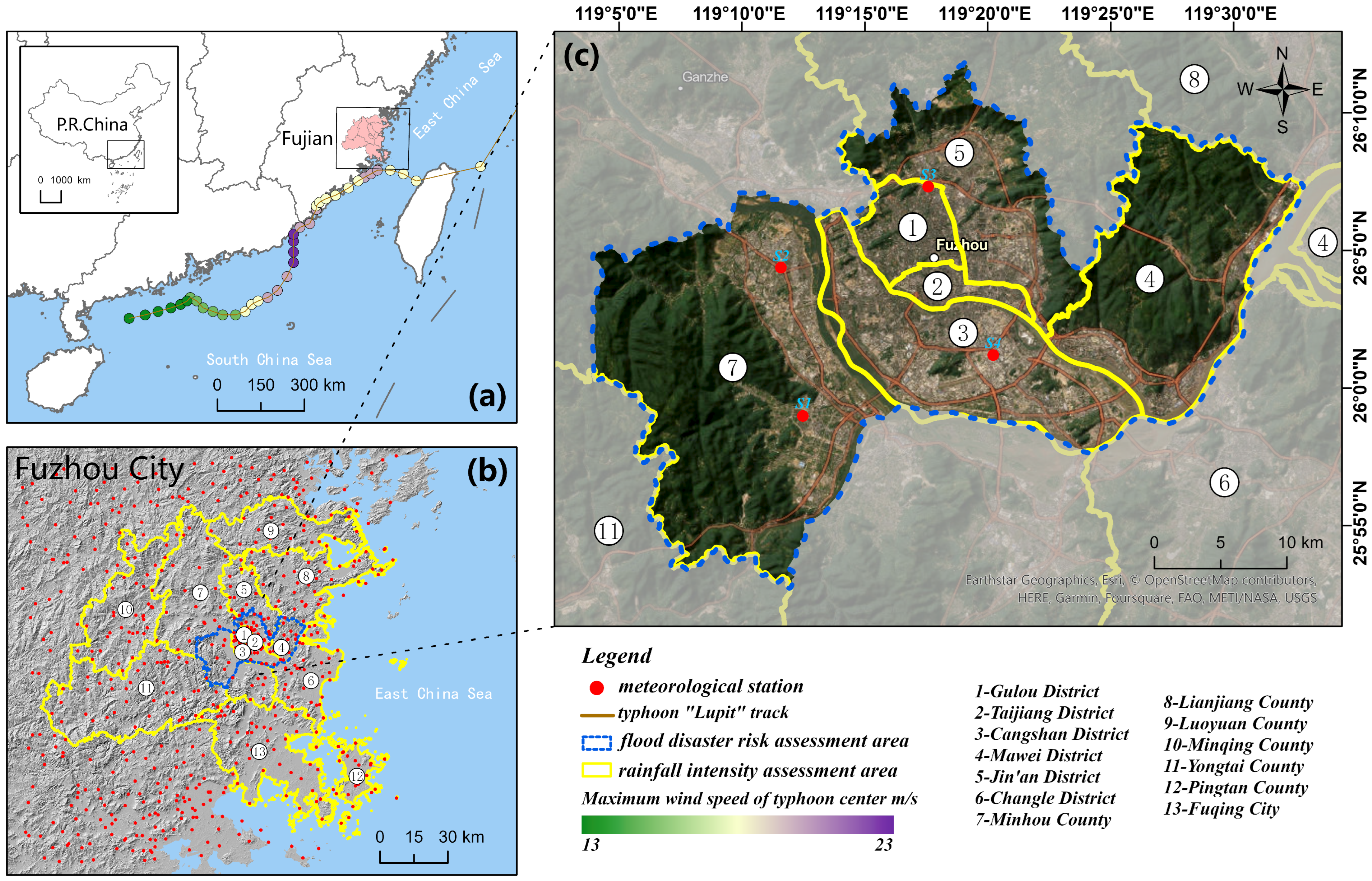
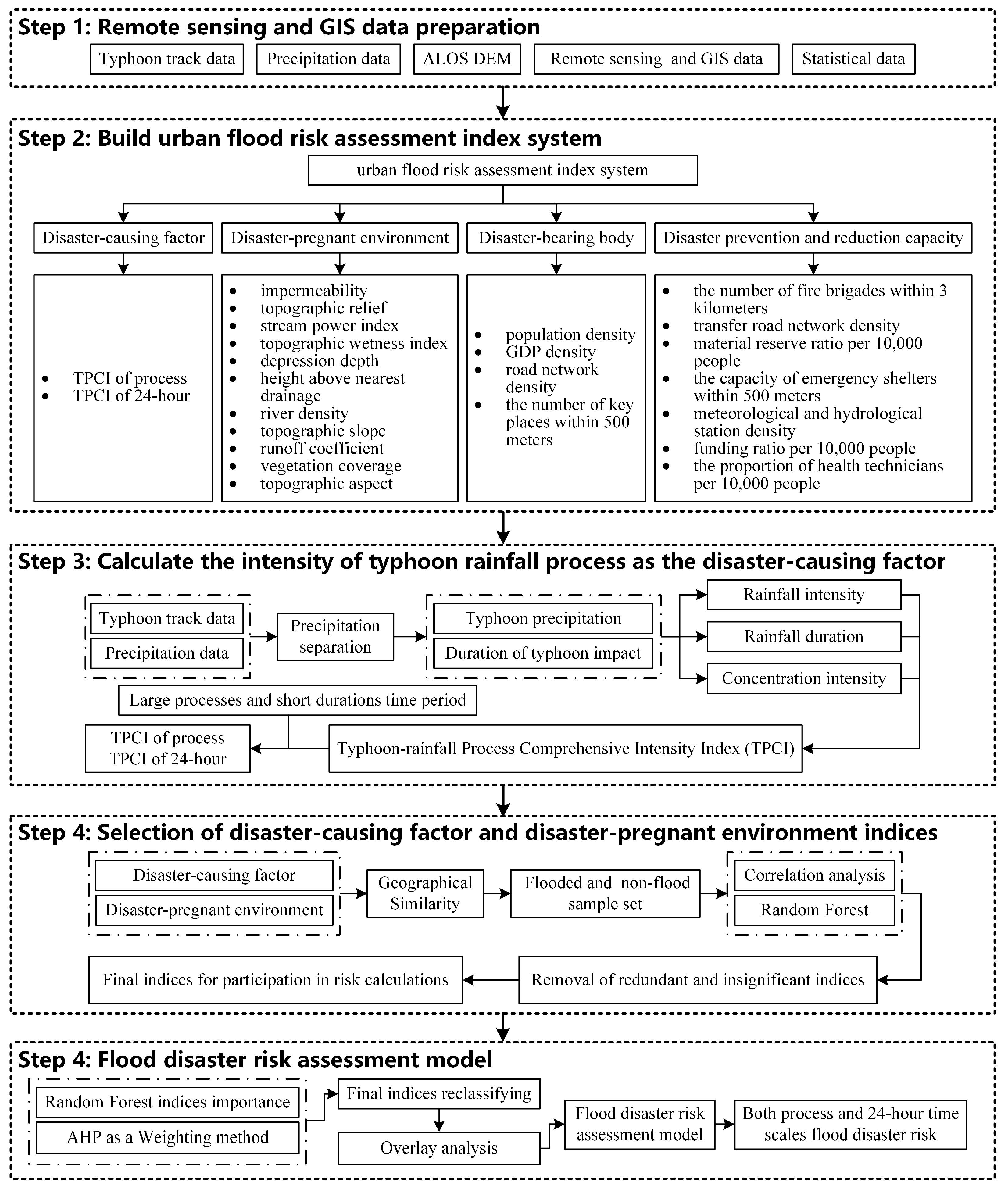
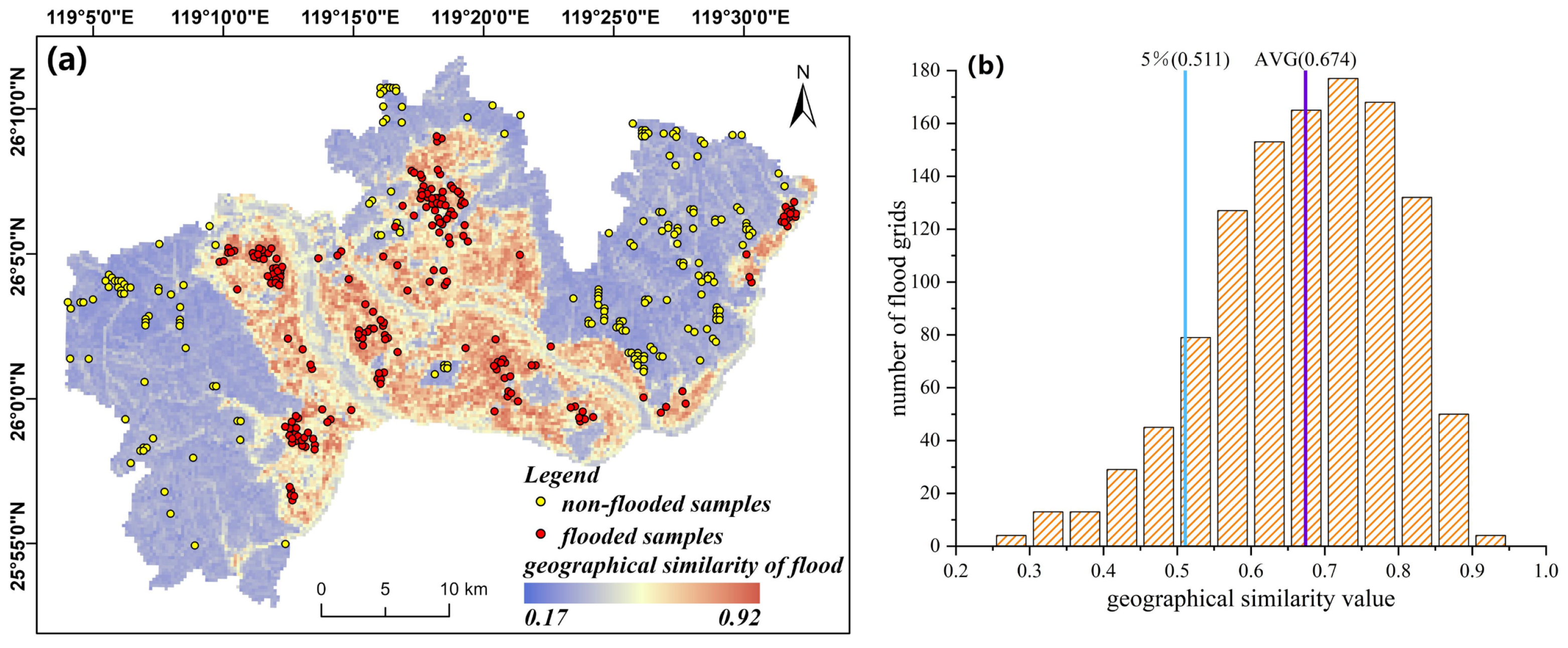
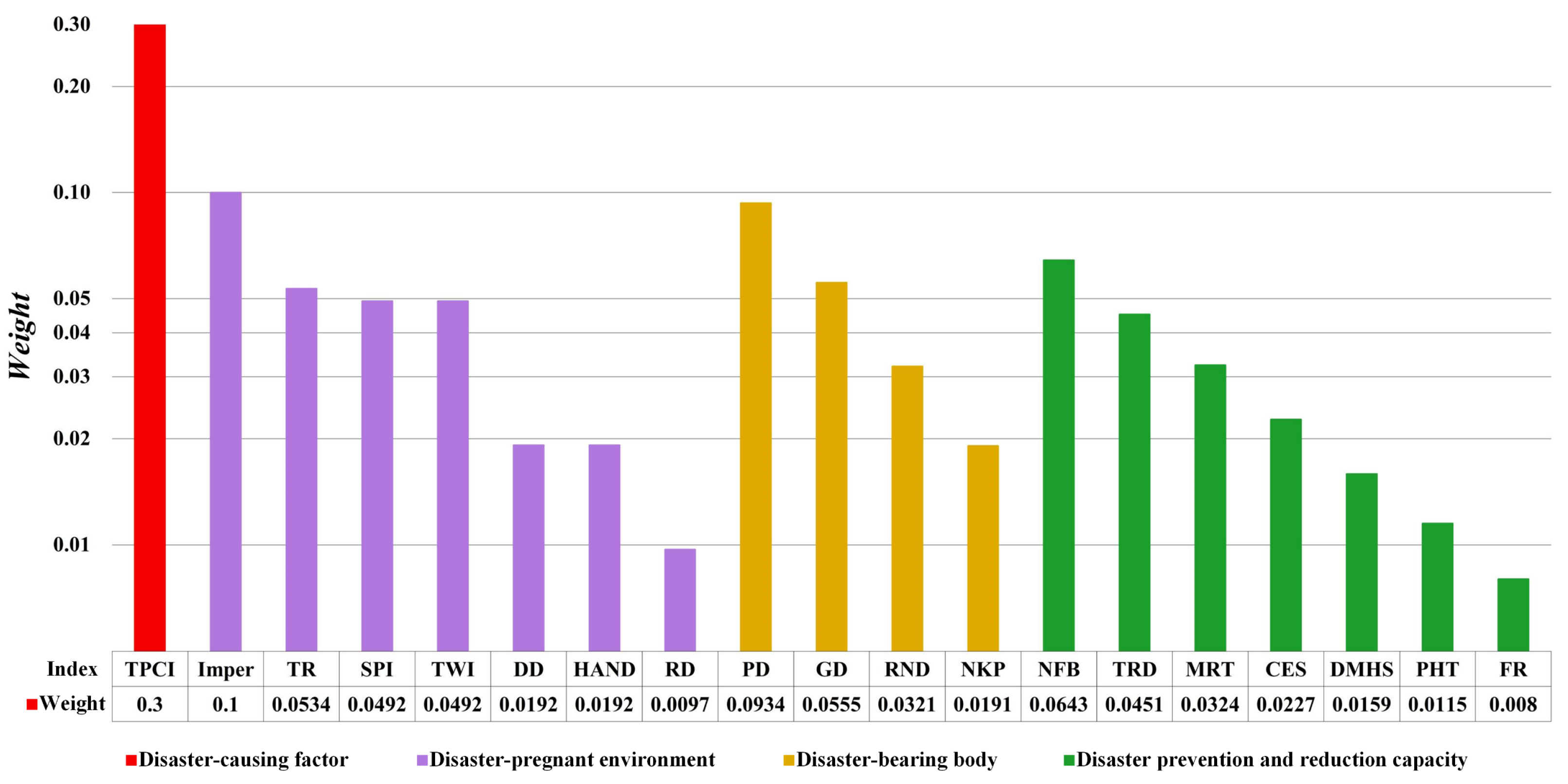

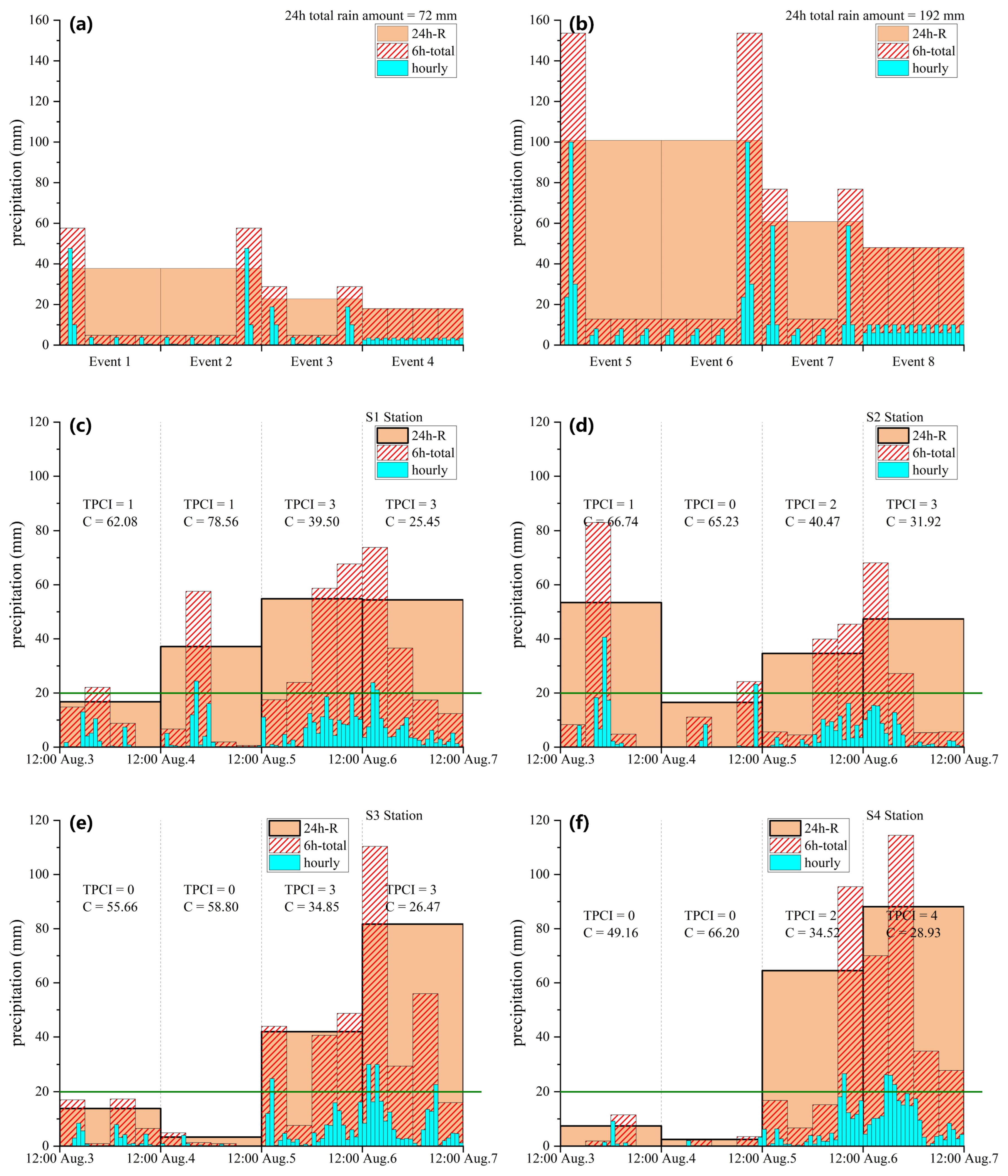
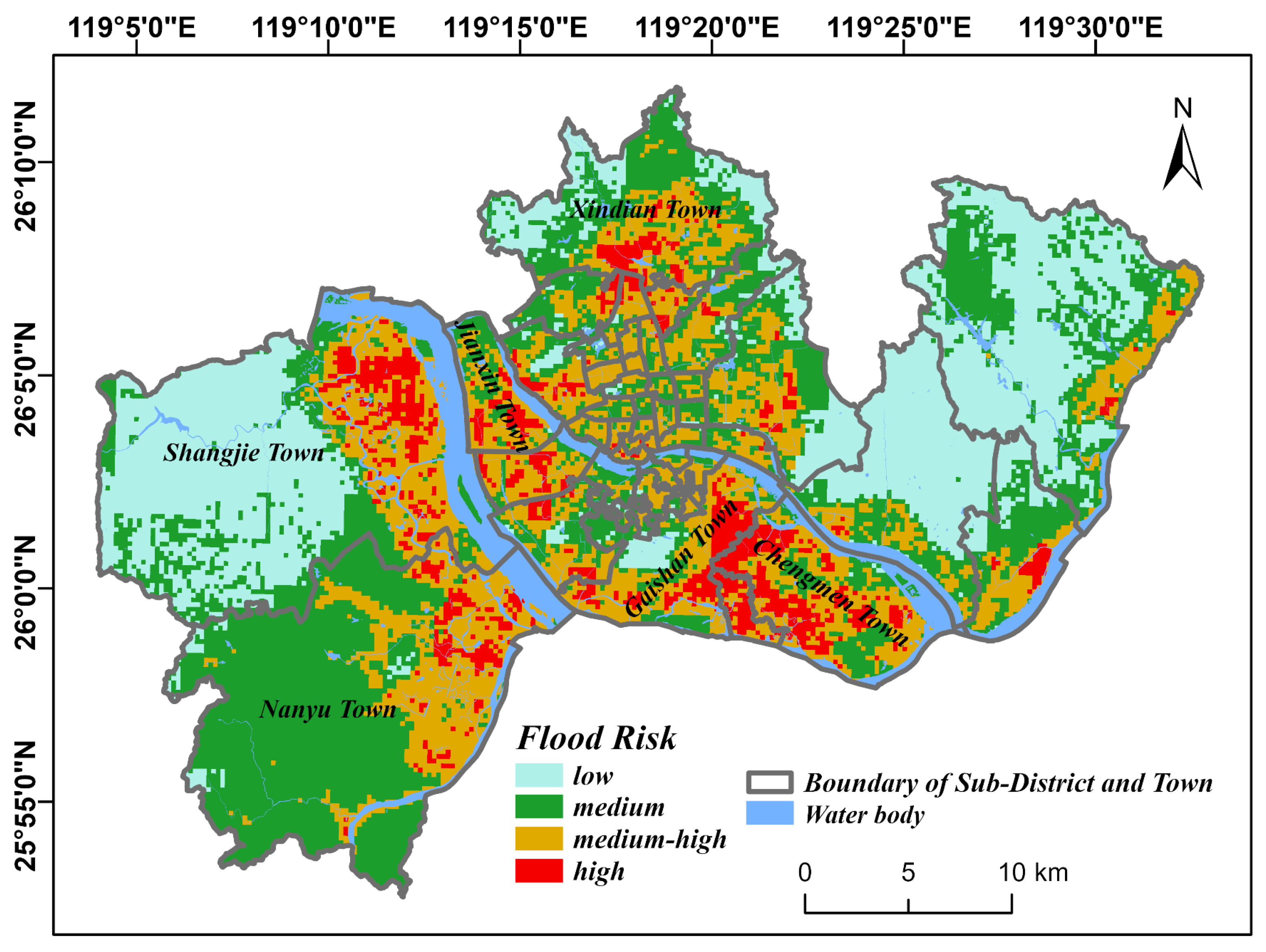
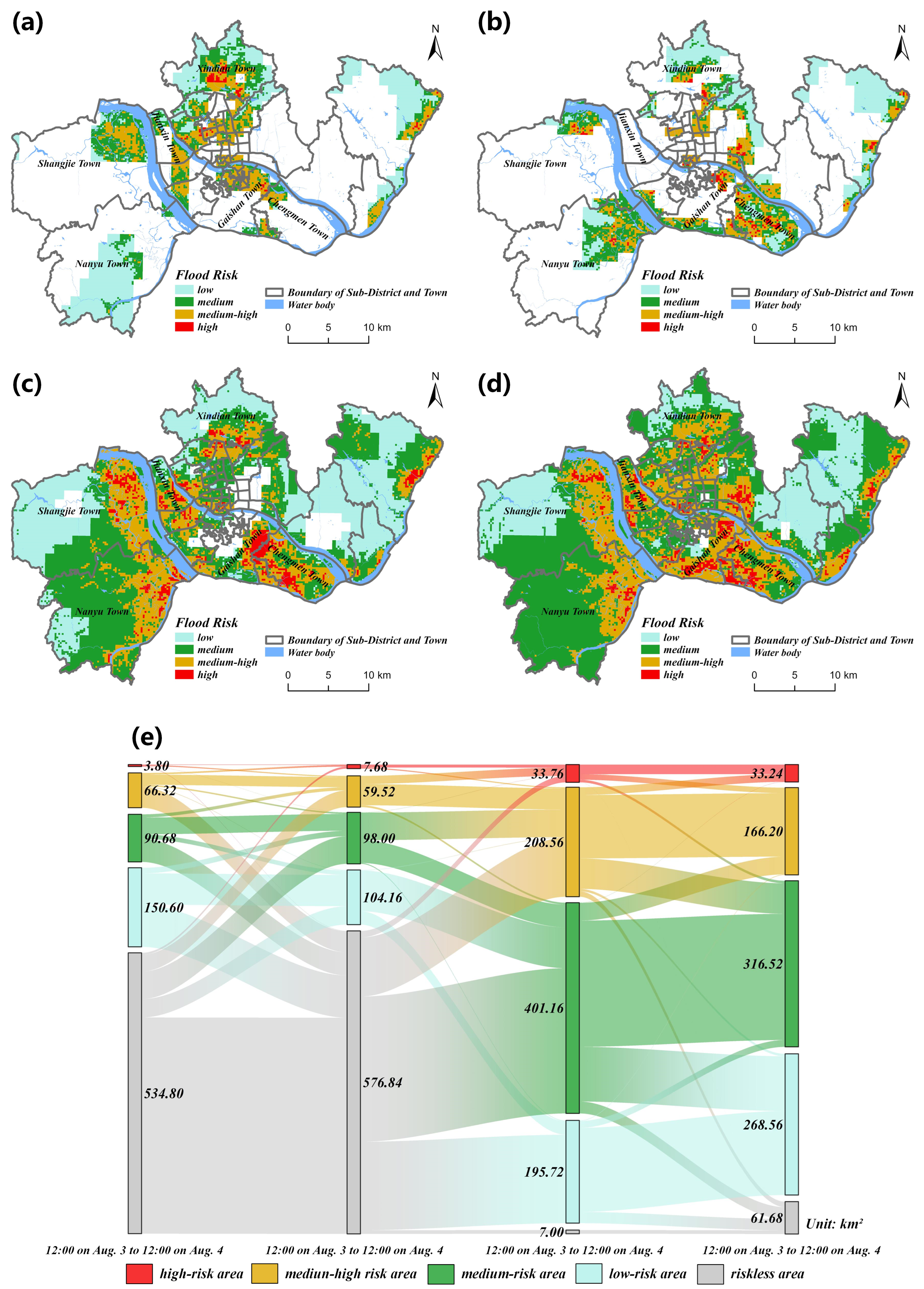

| Data Name | Data Type | Data Details | Source |
|---|---|---|---|
| Hourly precipitation | Attribute data | 1–10 August 2021 | Fujian Provincial Meteorological Bureau |
| Typhoon track | Attribute data | 2–15 August 2021 | https://tcdata.typhoon.org.cn, accessed on 15 June 2022 |
| Digital elevation model | AlOS DEM | 12.5 m | https://search.asf.alaska.edu/#/?dataset=ALOS, accessed on 15 June 2022 |
| Remote sensing data | Raster data | 30 m | https://developers.google.cn/earth-engine/datasets/catalog/landsat, accessed on 15 June 2022 |
| Land cover data | Raster data | 10 m | https://developers.google.cn/earth-engine/datasets/catalog/ESA_WorldCover_v100, accessed on 15 June 2022 |
| Building distribution | Raster data | 100 m | https://ghsl.jrc.ec.europa.eu/download.php?ds=bu, accessed on 15 June 2022 |
| Road distribution | Road network shapefile | 2021 | https://amap.com/, accessed on 20 June 2022 |
| GDP statistical data | Attribute data | 2021 | Fuzhou Statistical Yearbook |
| Population | Attribute data | 2021 | Fuzhou Statistical Yearbook |
| Hydrological stations distribution | Attribute data | 2021 | http://27.156.118.74:18800/web/html/index.html?module=yqxx, accessed on 20 June 2022 |
| Key sites distribution | Point of interest | 2021 | Fujian Provincial Disaster Reduction Center |
| Administrative village data | Attribute data | 2021 | Fujian Provincial Disaster Reduction Center |
| Fire brigade distribution | Point of interest | 2021 | https://amap.com/, accessed on 20 June 2022 |
| Hospitals distribution | Point of interest | 2021 | Fujian Provincial Disaster Reduction Center |
| Emergency shelters distribution | Attribute data | 2021 | Fujian Provincial Disaster Reduction Center |
| Flood disaster distribution | Attribute data | 3–8 August 2021 | http://zygh.fuzhou.gov.cn/, accessed on 20 June 2022, and news media coverage |
| Values | Process as TP, 24-h as Sub-TP | 24-h as TP, 6-h as Sub-TP | C of Sub-TP | ||
|---|---|---|---|---|---|
| R of Sub-TP | T | R of Sub-TP | T | ||
| 1 | [50, 75) | 2 | [20, 30) | 1 | [0, 10) |
| 2 | [75, 100) | 3 | [30, 40) | 2 | [10, 20) |
| 3 | [100, 125) | 4 | [40, 50) | 3 | [20, 25) |
| 4 | ≥125 | ≥5 | ≥50 | 4 | ≥25 |
| Criterion Name | Index Name | Low-Grade | Medium-Grade | Medium–High-Grade | High-Grade |
|---|---|---|---|---|---|
| Disaster-causing factor | TPCI | 1–16 | 17–32 | 33–48 | 49–64 |
| Disaster-pregnant environment | Imper | <0.25 | [0.25, 0.5) | [0.5, 0.75) | ≥0.75 |
| TR | ≥10 m | [5 m, 10 m) | [3 m, 5 m) | <3 m | |
| SPI | <2 | ≥6 | [2, 4) | [4, 6) | |
| TWI | <8 | [8, 12) | [12, 16) | ≥16 | |
| DD | <1 m | [1 m, 2 m) | [2 m, 3 m) | ≥3 m | |
| HAND | ≥10 m | [5 m, 10 m) | [3 m, 5 m) | <3 m | |
| RD | <0.25 | [0.25, 0.5) | [0.5, 0.75) | ≥0.75 | |
| Disaster-bearing body | PD | <1 | [1, 400) | [400, 800) | ≥800 |
| GD | <0.01 | [0.01, 0.25) | [0.25, 0.5) | ≥0.5 | |
| RND | <0.01 | [0.01, 0.5) | [0.5, 0.75) | ≥0.75 | |
| NKP | <1 | [1, 6) | [6, 11) | ≥11 | |
| Disaster prevention and reduction capacity | NFB | ≥7 | [4, 7) | [1, 4) | <1 |
| TRD | ≥0.2 | [0.1, 0.2) | [0.01, 0.1) | <0.01 | |
| MRT | ≥100 | [50, 100) | [1, 50) | <1 | |
| CES | ≥2000 | [1000, 2000) | [1, 1000) | <1 | |
| DMHS | ≥3 | [2, 3) | [1, 2) | <1 | |
| PHT | ≥100 | [50, 100) | [1, 50) | <1 | |
| FR | ≥100 | [50, 100) | [1, 50) | <1 |
| Rainfall Event | Rainfall Amount of 24-h | Description of Temporal Distribution | Calculation Process of TPCI |
|---|---|---|---|
| Event1 | 72 mm | Unimodal rainfall with early peak and maximum rainfall within a 6 h timeframe accounting for 80% of the 24 h total amount. | R/RI = 37.8 mm/2 TI = 1 C/CI = 69.69/4 TPCI = 8 |
| Event2 | 72 mm | Unimodal rainfall with late peak and maximum rainfall within a 6 h timeframe accounting for 80% of the 24 h total amount. | R/RI = 37.8 mm/2 TI = 1 C/CI = 69.69/4 TPCI = 8 |
| Event3 | 72 mm | Bimodal rainfall with early and late peaks, both the early maximum and the late one within a 6 h timeframe account for 40% of the 24 h total amount | R/RI = 22.8 mm/1 TI = 2 C/CI = 62.30/4 TPCI = 8 |
| Event4 | 72 mm | Uniform rainfall | R/RI = 18 mm/0 TI = 0 C/CI = 17.13/2 TPCI = 0 |
| Event5 | 192 mm | Unimodal rainfall with early peak and maximum rainfall within a 6 h timeframe accounting for 80% of the 24 h total amount. | R/RI = 100.8 mm/3 TI = 1 C/CI = 52.55/4 TPCI = 12 |
| Event6 | 192 mm | Unimodal rainfall with late peak and maximum rainfall within a 6 h timeframe accounting for 80% of the 24 h total amount. | R/RI = 100.8 mm/3 TI = 1 C/CI = 52.55/4 TPCI = 12 |
| Event7 | 192 mm | Bimodal rainfall with early and late peaks, both the early maximum and the late one within a 6 h timeframe account for 40% of the 24 h total amount | R/RI = 60.8 mm/1 TI = 2 C/CI = 59.79/4 TPCI = 8 |
| Event8 | 192 mm | Uniform rainfall | R/RI = 48 mm/1 TI = 4 C/CI = 17.71/2 TPCI = 8 |
| Calculation Period for TPCI | Unidentified * | Low * | Medium * | Medium-High * | High * | Total * |
|---|---|---|---|---|---|---|
| 12:00 on the 3rd–12:00 on the 4th | 0.03 | 1.17 | 10.36 | 0.35 | - | 11.91 |
| 12:00 on the 4th–12:00 on the 5th | 0.12 | 21.38 | 3.50 | 0.13 | - | 25.13 |
| 12:00 on the 5th–12:00 on the 6th | - | 32.54 | 12.12 | 37.35 | 5.74 | 87.75 |
| 12:00 on the 6th–12:00 on the 7th | 0.10 | 17.14 | 25.12 | 38.96 | 4.03 | 85.25 |
| Typhoon process | 2.48 | 10.47 | 31.13 | 45.9 | - | 89.98 |
Disclaimer/Publisher’s Note: The statements, opinions and data contained in all publications are solely those of the individual author(s) and contributor(s) and not of MDPI and/or the editor(s). MDPI and/or the editor(s) disclaim responsibility for any injury to people or property resulting from any ideas, methods, instructions or products referred to in the content. |
© 2023 by the authors. Licensee MDPI, Basel, Switzerland. This article is an open access article distributed under the terms and conditions of the Creative Commons Attribution (CC BY) license (https://creativecommons.org/licenses/by/4.0/).
Share and Cite
Qin, X.; Wu, Y.; Lin, T.; Gao, L. Urban Flood Dynamic Risk Assessment Based on Typhoon Rainfall Process: A Case Study of Typhoon “Lupit” (2109) in Fuzhou, China. Remote Sens. 2023, 15, 3116. https://doi.org/10.3390/rs15123116
Qin X, Wu Y, Lin T, Gao L. Urban Flood Dynamic Risk Assessment Based on Typhoon Rainfall Process: A Case Study of Typhoon “Lupit” (2109) in Fuzhou, China. Remote Sensing. 2023; 15(12):3116. https://doi.org/10.3390/rs15123116
Chicago/Turabian StyleQin, Xiaochen, Yilong Wu, Tianshu Lin, and Lu Gao. 2023. "Urban Flood Dynamic Risk Assessment Based on Typhoon Rainfall Process: A Case Study of Typhoon “Lupit” (2109) in Fuzhou, China" Remote Sensing 15, no. 12: 3116. https://doi.org/10.3390/rs15123116
APA StyleQin, X., Wu, Y., Lin, T., & Gao, L. (2023). Urban Flood Dynamic Risk Assessment Based on Typhoon Rainfall Process: A Case Study of Typhoon “Lupit” (2109) in Fuzhou, China. Remote Sensing, 15(12), 3116. https://doi.org/10.3390/rs15123116








